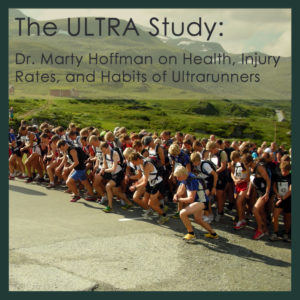The ULTRA Study: Dr. Marty Hoffman on Health, Injury Rates, and Habits of Ultrarunners
March 9, 2015 In this exclusive podcast we speak with Dr. Marty Hoffman and dive into the most extensive research to date on ultrarunners. Marty is the key researcher of The ULTRA Study, a longitudinal study on more than 1,200 ultrarunners that began in 2011 and will continue for years to come to find out what really happens when we run, a lot.
In this exclusive podcast we speak with Dr. Marty Hoffman and dive into the most extensive research to date on ultrarunners. Marty is the key researcher of The ULTRA Study, a longitudinal study on more than 1,200 ultrarunners that began in 2011 and will continue for years to come to find out what really happens when we run, a lot.
The most recent information was released in 2014 telling us so far some fascinating habits of ultrarunners which we discuss in detail on this show:
The Purpose
This study examines the prevalence of chronic diseases, health-care utilization, and risk factors for exercise-related injuries among ultramarathon runners.
No prior study has examined a large group of ultramarathon runners to assess prevalence of chronic medical conditions and how these individuals make use of the medical system.
Subjects & Duration
Med age: 42 (range: 18-81)
Gender: 68% men
Ethnic origin 93.5% white
Location: 88% US
Experience: 3,347km over 12mo (more than 2000 miles); (range 418–12,134 km)
HEALTH STATS
Common medical conditions:
- allergies and hay fever
- Exercise induced asthma
- (The respective prevalence for asthma and allergies was around 11% and 25% in the ultramarathoners, whereas the prevalence in American adults is around 8% and 7%)
Uncommon medical conditions:
- cancer
- coronary artery disease
- diabetes
- seizures
- HIV
- mental health disorders
This population is NOT using medical system as much as the general population.
- There was little use of the medical care system during the prior 12 months, but 64% of the outpatient medical visits were for exercise-related issues
INJURY STATS
- Common; most common site of injury: knee
- Younger/less experienced > older runners — Older age not a risk factor in injury!
- Equal injury rate to shorter distance runners
- Stress fractures more common though, and women > men (BMI did not differ between groups when considering men and women separately)
- Stress fractures: most (88.1%) indicated one had been sustained after they had started running at least 3 days per week; foot, lower leg, ankle.
- A majority, 933 (77.0%), of individuals in the study group reported exercise-related injuries in the prior 12 months.
- 1,900 injuries were reported.
- Exercise-related injuries that resulted in lost training of at least 1 day in the prior year were reported by 783 (64.6%).
“NONATTENDANCE” ISSUES
How do ultrarunners fare vs average population when it comes to missing work or school due to illness or injury (hint: runners are seemingly more willing to tough it out and show up!)
Compared with the general population, ultramarathon runners appear healthier and report fewer missed work or school days due to illness or injury.
- Only missed 2.2 days vs 3.7 days of avg population ages 18-74
- The average number of days in which more than half the day was spent in bed due to any illness or injury in the prior year was 1.0 among the ultramarathoners, compared with the 4.7 days reported for adult Americans
- Why are ultrarunners like this, what are their demographics?
Grab a free copy of this article.
For more research on ultrarunners visit wser.org’s site
Add your thoughts